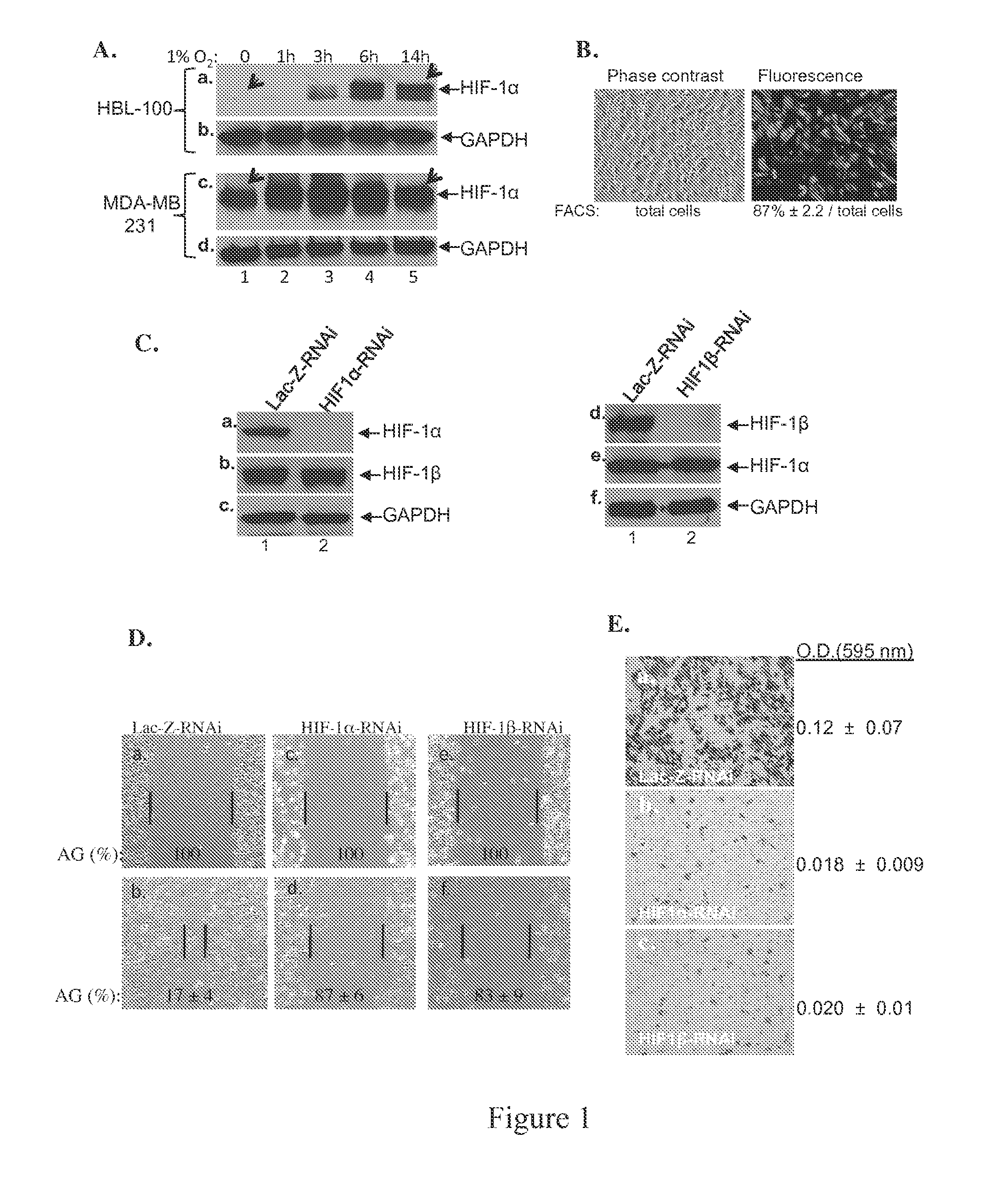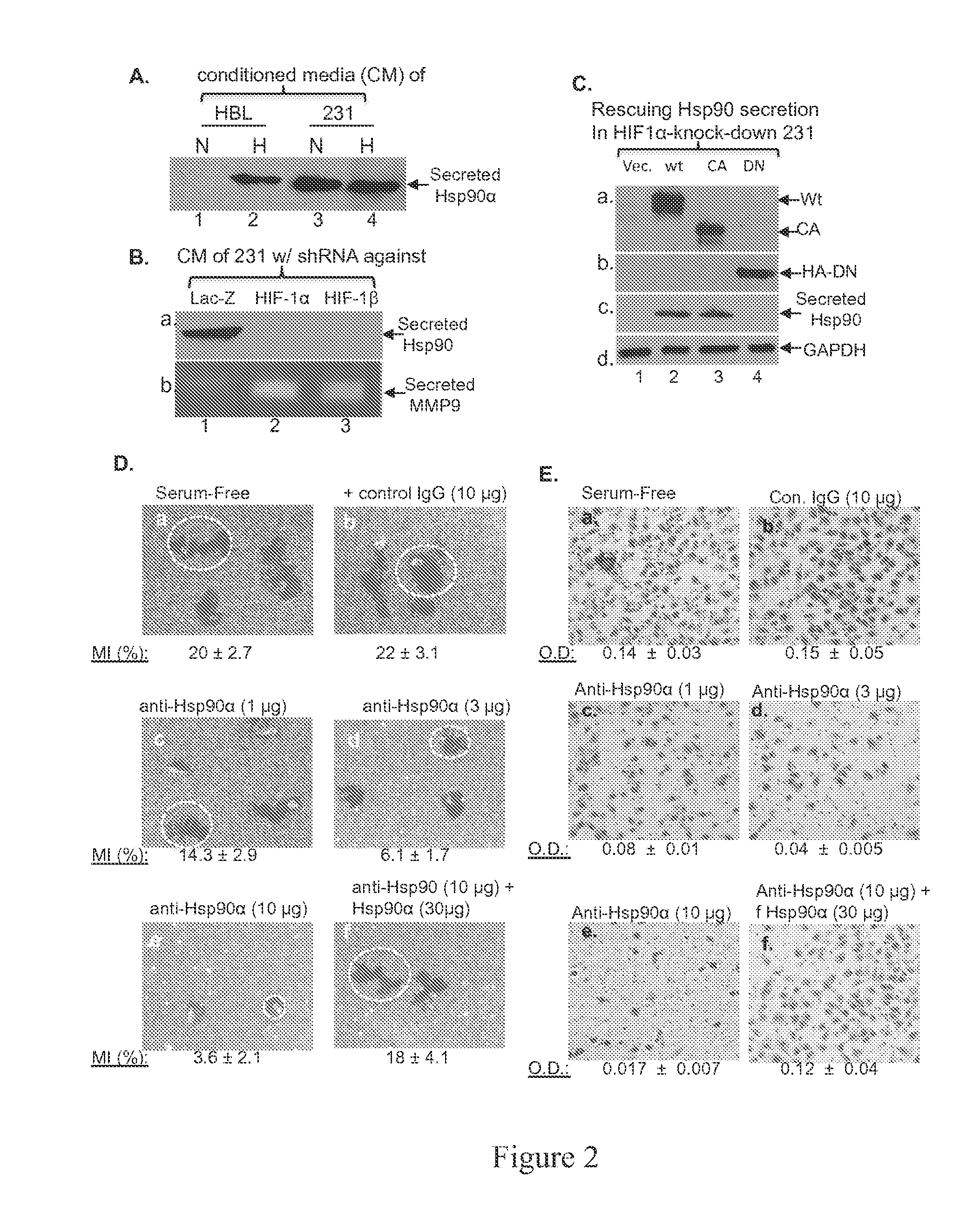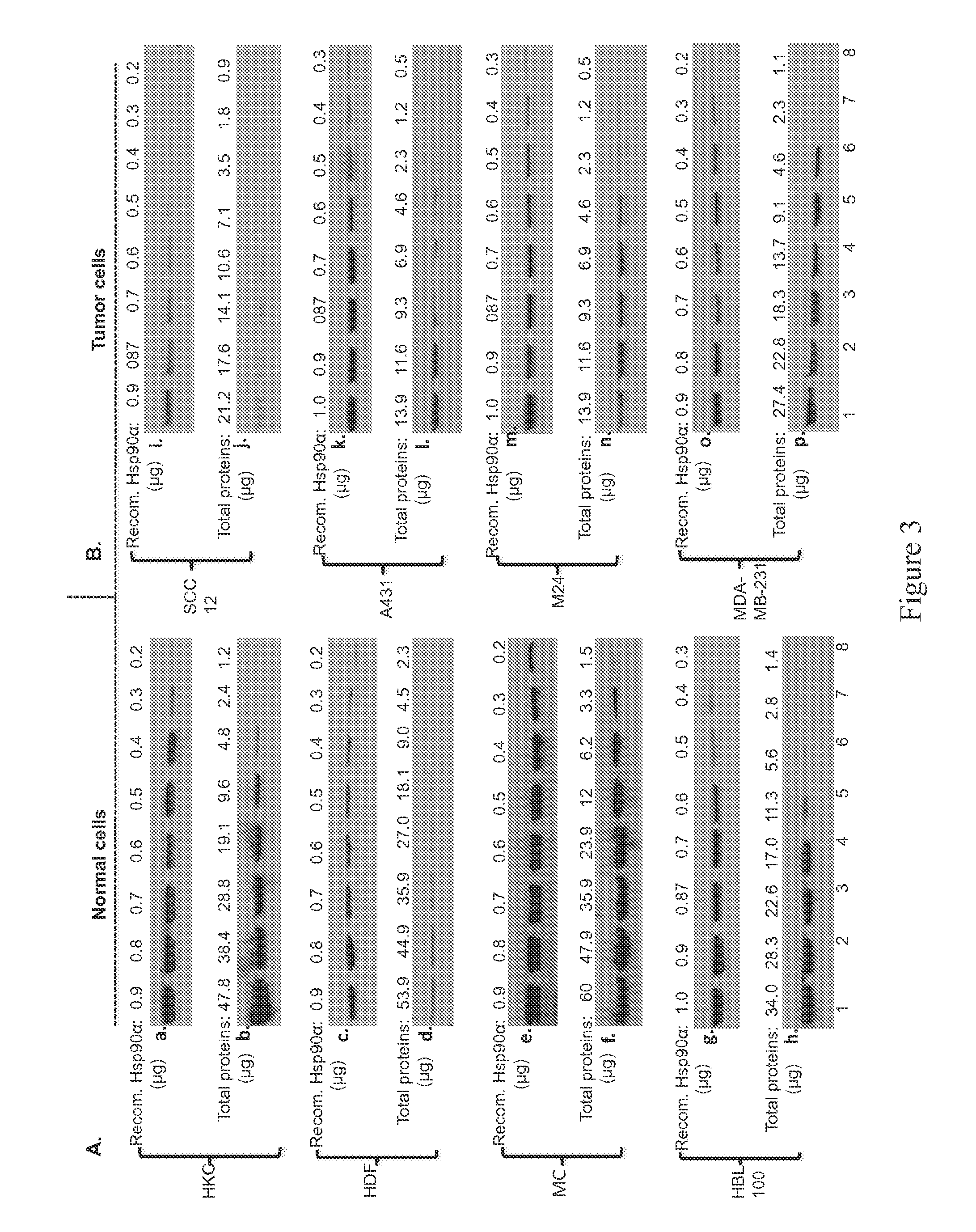Fragment of secreted heat shock protein-90alpha (hsp90alpha) as vaccines or epitope for monoclonal antibody drugs or target for small molecule drugs against a range of solid human tumors
a technology of heat shock protein and fragment, which is applied in the direction of peptide/protein ingredients, dna/rna fragmentation, depsipeptides, etc., can solve the problems of rapid rise in hif-1 levels in the cells, and direct targeting of intracellularly located hif-1 or the enzymes that regulate hif-1 stability, so as to prevent hif-1-overexpressing cancer metastasis, inhibit hif-1
- Summary
- Abstract
- Description
- Claims
- Application Information
AI Technical Summary
Benefits of technology
Problems solved by technology
Method used
Image
Examples
example 1
[0085]Cell lines screened for deregulated HIF-1α expression included: HB1-100 human breast epithelial cell line, four human breast cancer cell line (MDA-MB-231, MDA-MB-468, MDA-MB-435 and MCF-7), M24 and M21 human melanoma cell lines, U251 and U87 human glioma cell lines, A172 human glioblastoma cell line, PC3 human prostate cancer cell line and A431 human skin carcinoma cell line. Native rat-tail type I collagen was from BD Biosciences (Bedford, Mass.). Colloidal gold (gold chloride, G4022) was purchased from SIGMA (St. Louis, Mich.). The cDNAs that encode HIF-1α (wt), HIF-1αCA5 (constitutively active) and HIF-1αΔNBΔAB (dominant negative) were gifts from Dr. Gregg Semenza (Johns Hopkins University) and cloned into lentiviral vector, pPPLsin.MCS-Deco (20). ShRNAs against human HIF-1α and HIF-1β were cloned in lentiviral FG-12 system, as previously described (39). Anti-HIF-1α antibody (#610958) and anti-HIF-1β antibody (#611078) were from BD Transduction Laborator...
example 2
A Constitutive Level of HIF-1α is Essential for Invasiveness of Breast Cancer Cells
[0096]Applicants wanted to identify a tumor cell line with deregulated expression of HIF-1α and use this cell model for identifying new downstream effectors of the deregulated HIF-1α essential for cell invasion in vitro and tumor formation in vivo. After screening various tumor cell lines (listed in Materials and Methods), Applicants focused on the ER-negative and Ah-nonresponsive breast cancer cell line, MDA-MB-231, previously isolated from pleural effusion obtained from 51-years old patient, invasive and metastatic (4). This choice also considered the clinical data that approximately 30% of invasive breast cancer samples are hypoxic (10, 22). The untransformed human epithelial cells, HBL-100 (13), were included as a control. As shown in FIG. 1A, in HBL-100 cells, the HIF-1α level was undetectable under normoxia (panel a, lane 1). A time-dependent accumulation of HIF-1α protein was detected from the ...
example 3
Deregulated HIF-1α in Breast Cancer Causes Constitutive Hsp90α Secretion
[0098]Applicants conducted a search for targets of deregulated HIF-1α for three criteria: 1) constitutively secreted by MDA-MB-231 cells, 2) under direct control of the deregulated HIF-1α and 3) essential for the invasiveness of the cells. Applicants focused on secretion of heat shock protein-90α (Hsp90α) based on following evidence. First, Eustace et al showed that HT-1080 fibrosarcoma cells secrete Hsp90α (12). Second, hypoxia causes normal cells to secrete Hsp90α (19). Third, secreted Hsp90α mediates hypoxia-driven cell migration (42). Therefore, Applicants tested the possibility that the deregulated HIF-1α causes Hsp90α secretion, leading to increased migration and invasion of MDA-MB-231 cells. Serum-free conditioned media (CM) of HBL-100 and MDA-MB-231 cells cultured under either normoxia or hypoxia were analyzed for the presence of Hsp90α. As shown in FIG. 2A, secreted Hsp90α was detected from the CM of HL...
PUM
| Property | Measurement | Unit |
|---|---|---|
| nucleic acid | aaaaa | aaaaa |
| pharmaceutical composition | aaaaa | aaaaa |
| distance | aaaaa | aaaaa |
Abstract
Description
Claims
Application Information
 Login to View More
Login to View More - R&D
- Intellectual Property
- Life Sciences
- Materials
- Tech Scout
- Unparalleled Data Quality
- Higher Quality Content
- 60% Fewer Hallucinations
Browse by: Latest US Patents, China's latest patents, Technical Efficacy Thesaurus, Application Domain, Technology Topic, Popular Technical Reports.
© 2025 PatSnap. All rights reserved.Legal|Privacy policy|Modern Slavery Act Transparency Statement|Sitemap|About US| Contact US: help@patsnap.com



